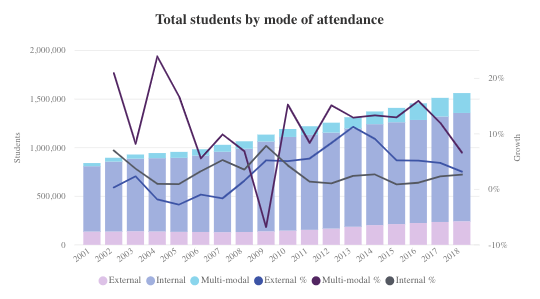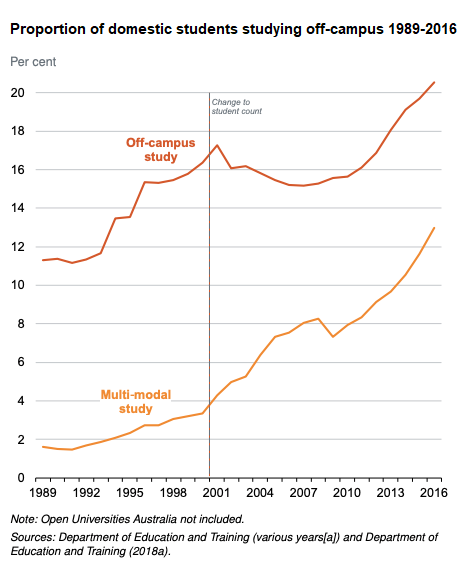
CEO Connect #7: Member Engagement, Unimutual Financial Strength and looking ahead
April 14, 2020
Member Matters Issue #2, 2020
May 6, 202010 risks you may not have considered
Even prior to COVID-19 and social distancing requirements, online learning has been increasing in popularity for years, with numbers of external students and multi-modal students (those studying both on and off campus) consistently growing, according to government data.
Source: Higher Education Statistics Collection, Department of Education

Total student numbers over the last 17 years have grown significantly, but the proportion of these that are multi-modal learners continues to grow far beyond internal students. The bar graph above tracks student numbers and the line graph tracks the annual growth (%) of each learning style. You can see that the growth in multi-modal in particular, but also external, student numbers is higher than the growth of internal students.
More students have been choosing to study remotely, especially for postgraduate studies, attracted by the flexibility it offers to balance study with full-time jobs and other commitments. According to Grattan Institute research from 2019, the Australian average showed that about one in five students were studying off campus, but when multi-modal study is included, about one in three students were undertaking a significant part of their study off campus.

The transition to online learning is definitely a great opportunity for the sector to become more efficient and far reaching, however overly rapid or unplanned implementation is risky. As with all new models, there are misunderstood or unseen risks that can cause issues down the line. And now, for many, the transition to online learning has been unexpectedly accelerated due to the COVID-19 virus significantly disrupting the sector.
Governments are trying to slow the spread of the illness with social distancing measures, closure of venues including bars and gyms, travel bans and mandatory quarantine periods. Most universities, colleges and other facilities are instructing staff and students to work and study from home in order to best support these social distancing instructions.
These measures mean that many institutions are looking for ways to bypass the disruption and continue to operate in this new normal, while minimising the risk of an outbreak on campus. Many learning institutions in Australia have announced that they will be switching to online classes only in response to the exponential number of cases. Most campuses remain open despite the lack of students, as the important function of medical research is continuing to take place. There is great uncertainty about when restrictions will be lifted.
Regardless of your long term strategy, the need to react to COVID-19 has seen online learning become a significant feature for the sector. But have you considered all the risks and implications of this transition and how to manage them?
More content available to Members Only
Login To Unlock The Content.To subscribe to Emerging Risk Reports or other Unimutual updates, please send your details to service@unimutual.com.au or follow us on LinkedIn for notifications.



